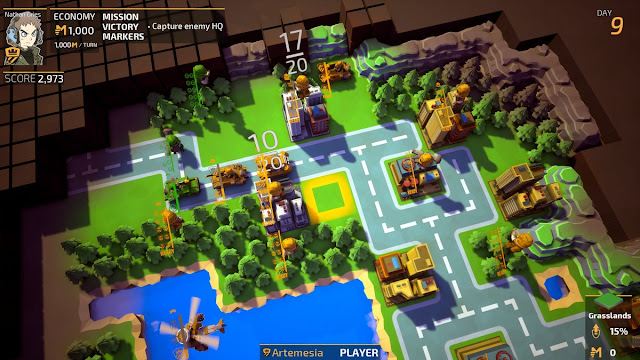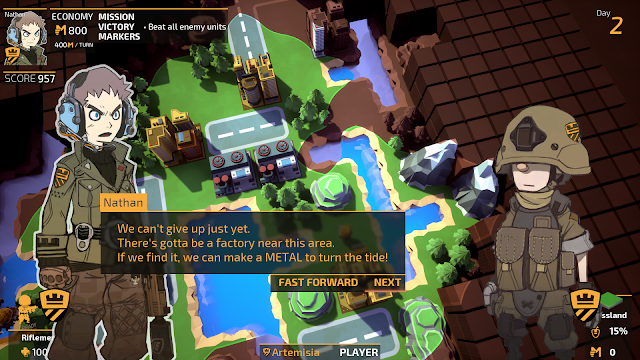Review by Matt S.
It’s been around a decade since Nintendo allowed Intelligent Systems to produce a new Advance Wars game. Fire Emblem’s simply become the bigger and more valuable franchise, and Nintendo’s focused the developer on that series instead. Fair enough for big Fire Emblem fans like myself, but hope of a new Advance Wars dwindles ever further for the fans of that particular franchise (and there is indeed a community of very big fans for Advance Wars).
Tiny Metal, by developer Area 35, tries to fill the gap with its own homage (read: blatant copy) of the Advance Wars franchise. Sadly, as earnest as the attempt is, the game itself is jut not that good. The thing about Advance Wars is that, based purely on the tactical strategy experience, it’s quite weak. I know I’ve just penned down a blasphemy that’s going to damn me to the very lowest levels of hell as far as some are concerned, but the reality is that Advance Wars strips almost any sense of strategic depth out of its tactics system in the interest of streamlining the experience to the point that anyone could pick it up and enjoy their time with it. Build units (preferably a mix between short and long range), and position infantry so they can duck and weave through the chaos to capture buildings, which provides more resources to build more units. That’s about all there is to it.
Overwhelming your opponent with sheer numbers and strength is the only real path to victory, and on any given level, after the initial rush to secure unoccupied buildings, whichever side first ends up with more buildings (and thus more resources) will almost always be the one to slowly steamroll the opponent. All they need to do is settle into a slow grind to leverage superior troop buying power and to push enemy units back until there’s nothing left.
Come from behind victories, where good strategic play with smaller numbers can overcome a larger enemy, are almost impossible to achieve in Advance Wars because there is no concept of morale or supply lines to disrupt. You can’t bribe unit leaders to switch sides mid battle, the quality of the individual units is equal (so there’s no elite squads, or alternatively poorly disciplined conscripts) and while you have the option to either capture the enemy’s headquarters, or destroy all of its units, to claim victory, in almost all circumstances, you’ll find that you’ll have destroyed all the enemy units well before you have a chance to capture the base – it’s usually buried right at the back of the enemy’s forces.
Tiny Metal is all this tradition, taken straight from Advance Wars, though in fairness the developers have tried to add a couple of features to deepen the strategic play. One example is the “lock on” command. Rather than attack a tough unit outright, a weaker unit can opt to “lock on” to it. Then, when you bring a second unit next to the locked on enemy and choose to attack, both units will fire simultaneously before the enemy can counter-attack. This helps Tiny Metal break apart from the arms race of Advance Wars games where each side would simply rush to build the biggest, most expensive weapons in great numbers. In Tiny Metal, more modest units can gang up on those big tanks to inflict serious damage, and that’s one step in the right direction to tactical depth.
The other key tactical addition is the ability to reduce the amount of damage a unit does in order to be able to “push” the enemy unit back one square on the map, with your unit occupying that now vacated space. This allows you greater strategic options when trying to control the battlefield (and is especially effective in preventing enemy infantry from capturing buildings.
Both of these features are important additions, and would have been even better if the AI had a halfway decent understanding on how to make use of these tactical options. Nevertheless, even if the AI was modelled after Napoleon himself, compared with strategy games like Nobunaga’s Ambition, Civilization, or Europa Universalis, tactics RPGs like Final Fantasy Tactics or God Wars, tactical strategy games like Battlestar Galactica Deadlock, or anything published by Slitherine, Tiny Metal doesn’t do enough to push genuine, long-term depth into the Advance Wars formula. There’s an argument to make that these games fulfill a role as a very entry level strategy game for people to later graduate to, but that doesn’t change the fact that these games in and of themselves are shallow and limited.
Where Advance Wars got much of its charm (and play value) was in having different commanders, each with their own skills and personality, which helped to keep battles themselves varied as each commander required a slightly different approach (in terms which units you’d mass produce as part of the standard steamroll strategy) to defeat, and, more importantly, those commanders made the story mode interesting to follow along with. Tiny Metal greatly lacks for personality in its characters. Despite cut scenes being quite lengthy, none of the characters say much of worth to one another, and while the campaign is a solid ten or so hours in length, I lost interest in following along with why the various forces were fighting within the first couple of missions. It doesn’t help that the art style used to draw these characters is deeply unattractive, which is itself at odds with the rest of the game because on the battlefield itself units and maps are quite attractive.
There is a lot to do in the game, though, I’ll give it that. Beyond the campaign there are loads of skirmish battle maps to play through, and while there isn’t a multiplayer mode yet, we are promised that that is coming. Let’s face it, that’s where the real appeal of Advance Wars has always been anyway, so that update couldn’t come quickly enough to Tiny Metal. Sadly, there isn’t a map editor, which has been a feature of some Advance Wars games in the past, and being able to build your own maps to compete on would have been a really appealing feature – especially in conjunction with the multiplayer mode – that really could have extended the longevity of Tiny Metal.
Ultimately, what I’m looking for in a strategy or tactics game is a system that abstracts real-world military strategy into something that’s palatable, but equally rich in strategic options. I need the agency to approach a battle in my own way, rather than simply mastering a singular strategy that the limitations that an overly simple engine force on me. What Tiny Metal, as a clone of Advance Wars, does unfortunately abstract things too far, to the point where there’s no real strategic depth left. It’s decent fun and there’s certainly a lot to it, and that multiplayer mode, when it comes, will be a good time waster with a couple of beers on a lazy Sunday afternoon, but as a tactics or strategy game it’s all too limited for its own good.
– Matt S.
Editor-in-Chief
Find me on Twitter: @digitallydownld
 |
| Please Support Me On Patreon!
|











